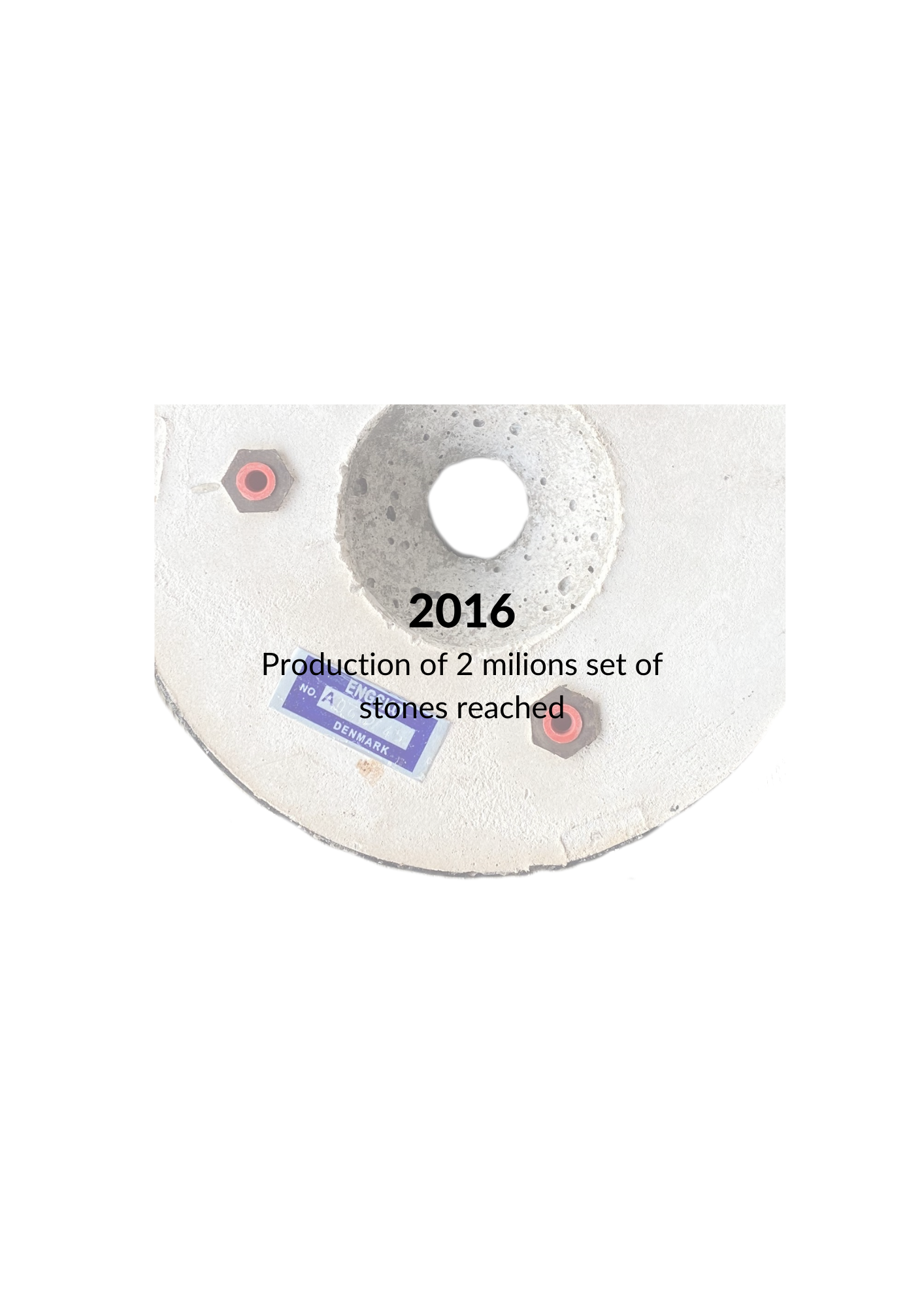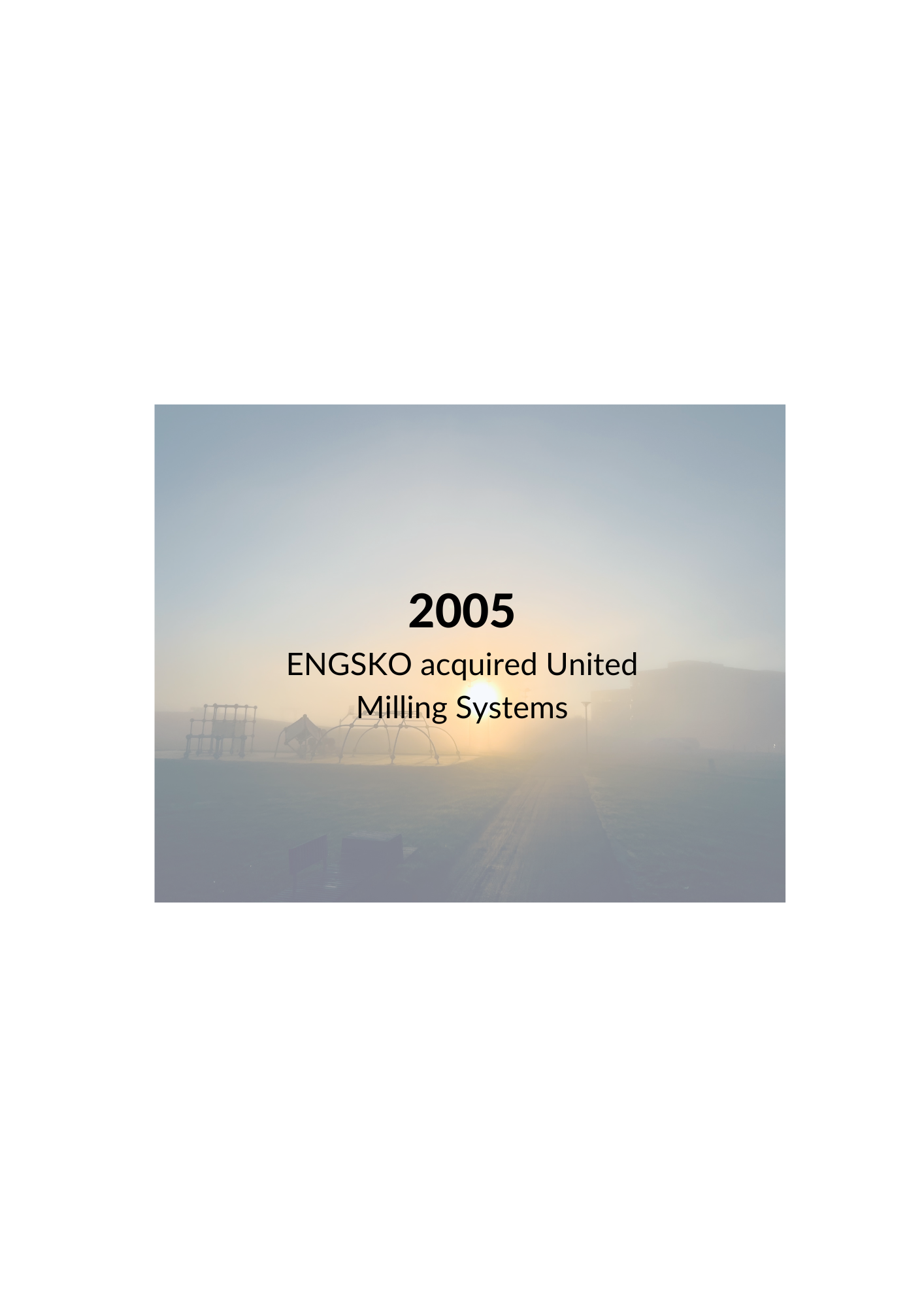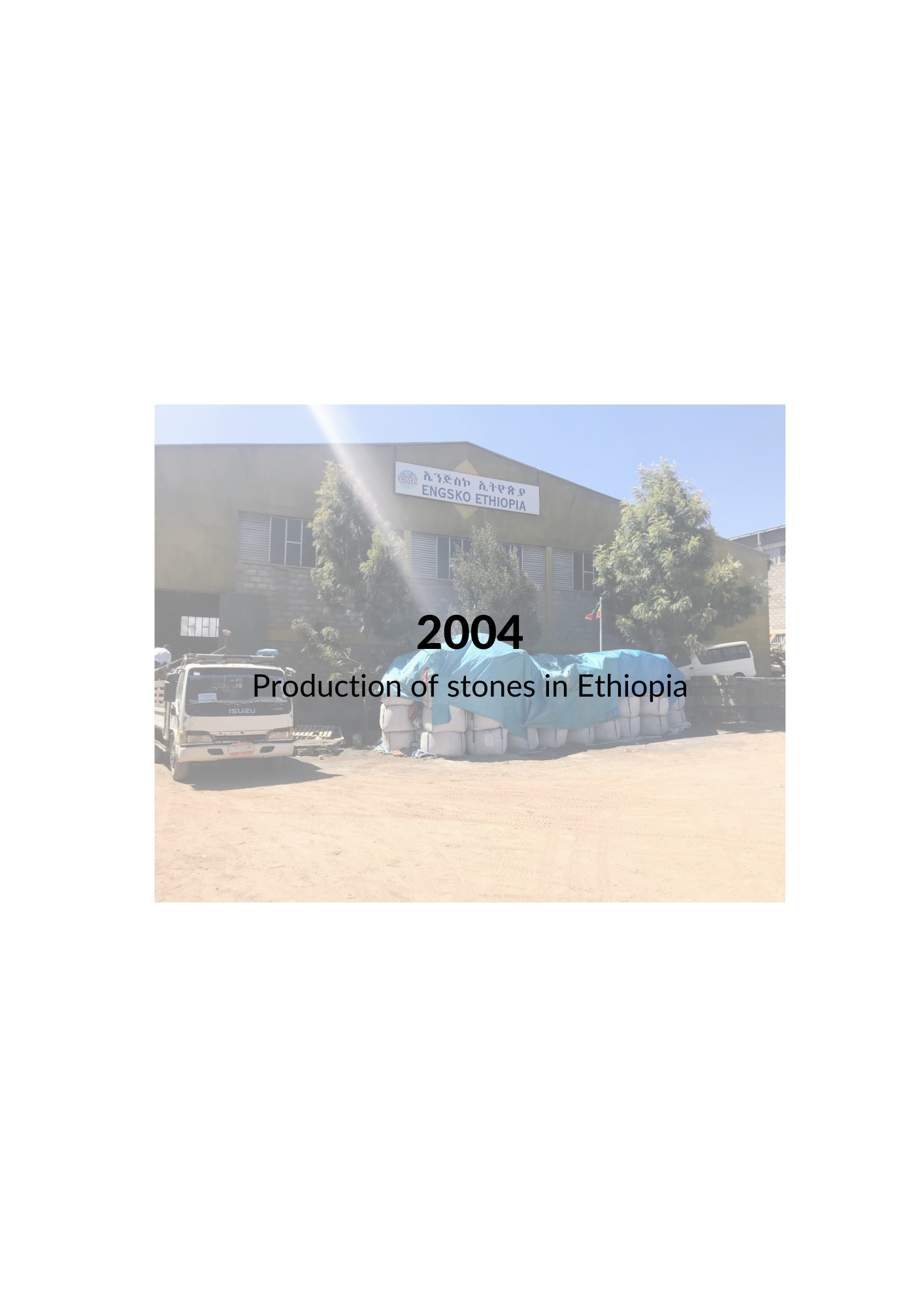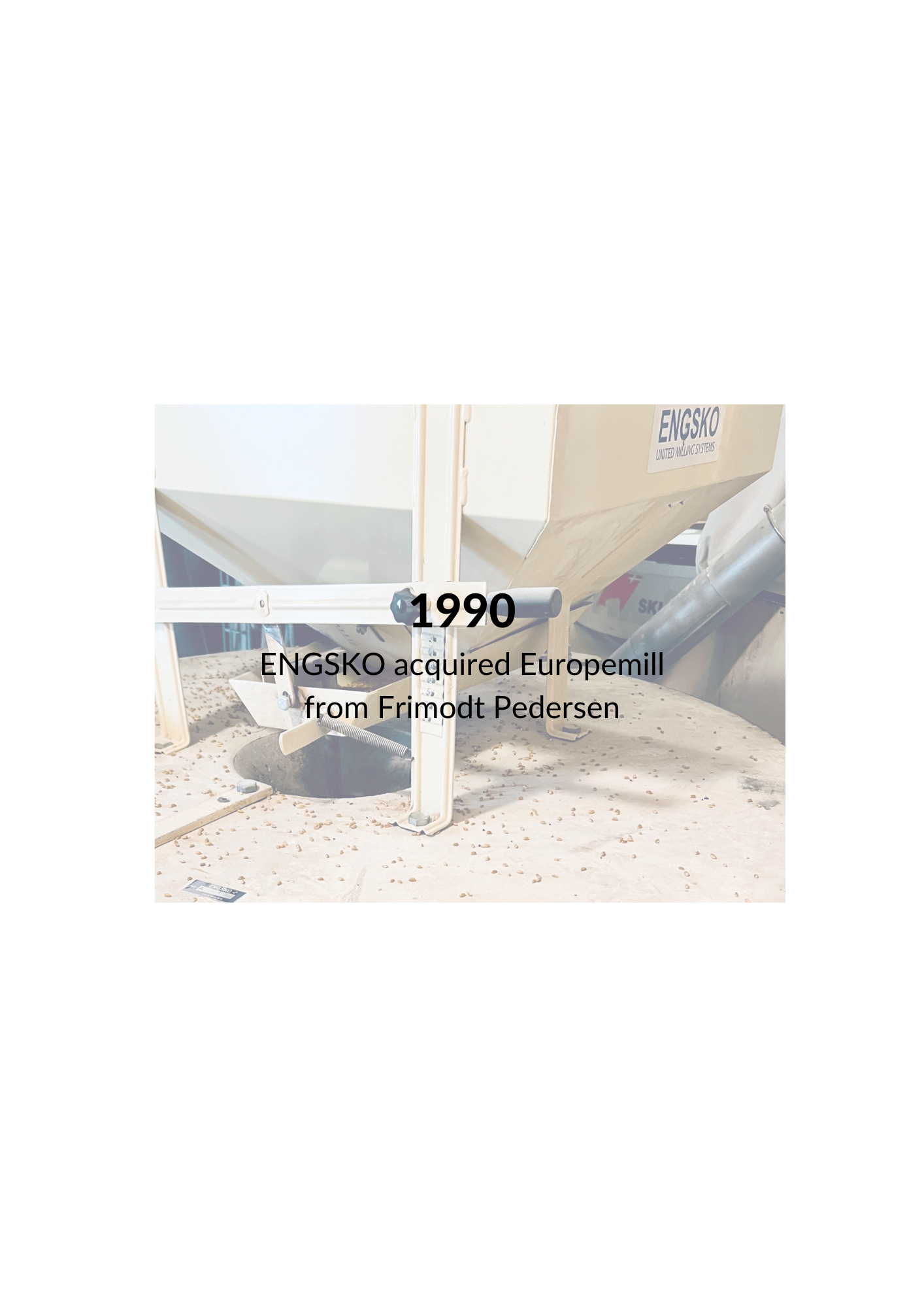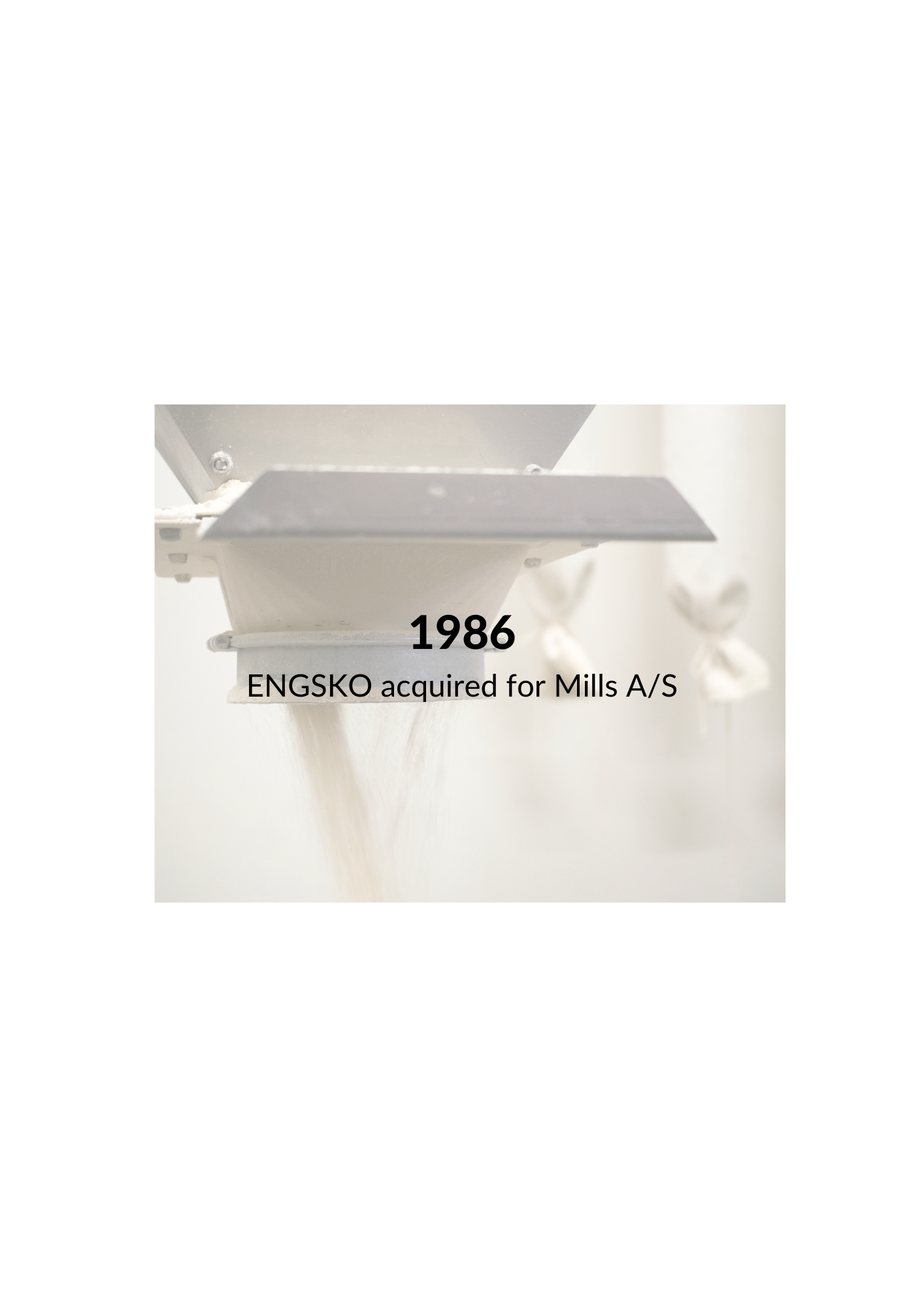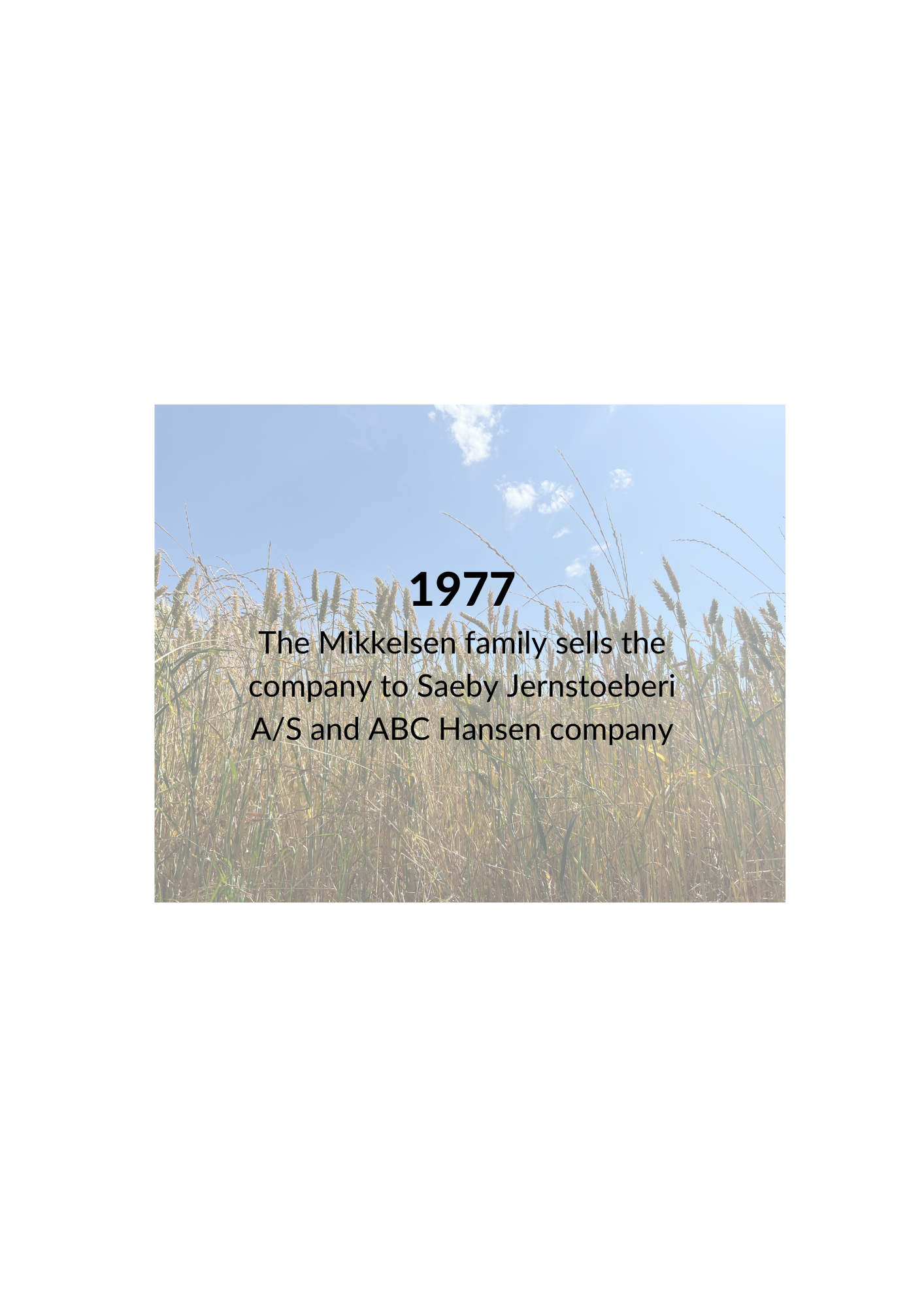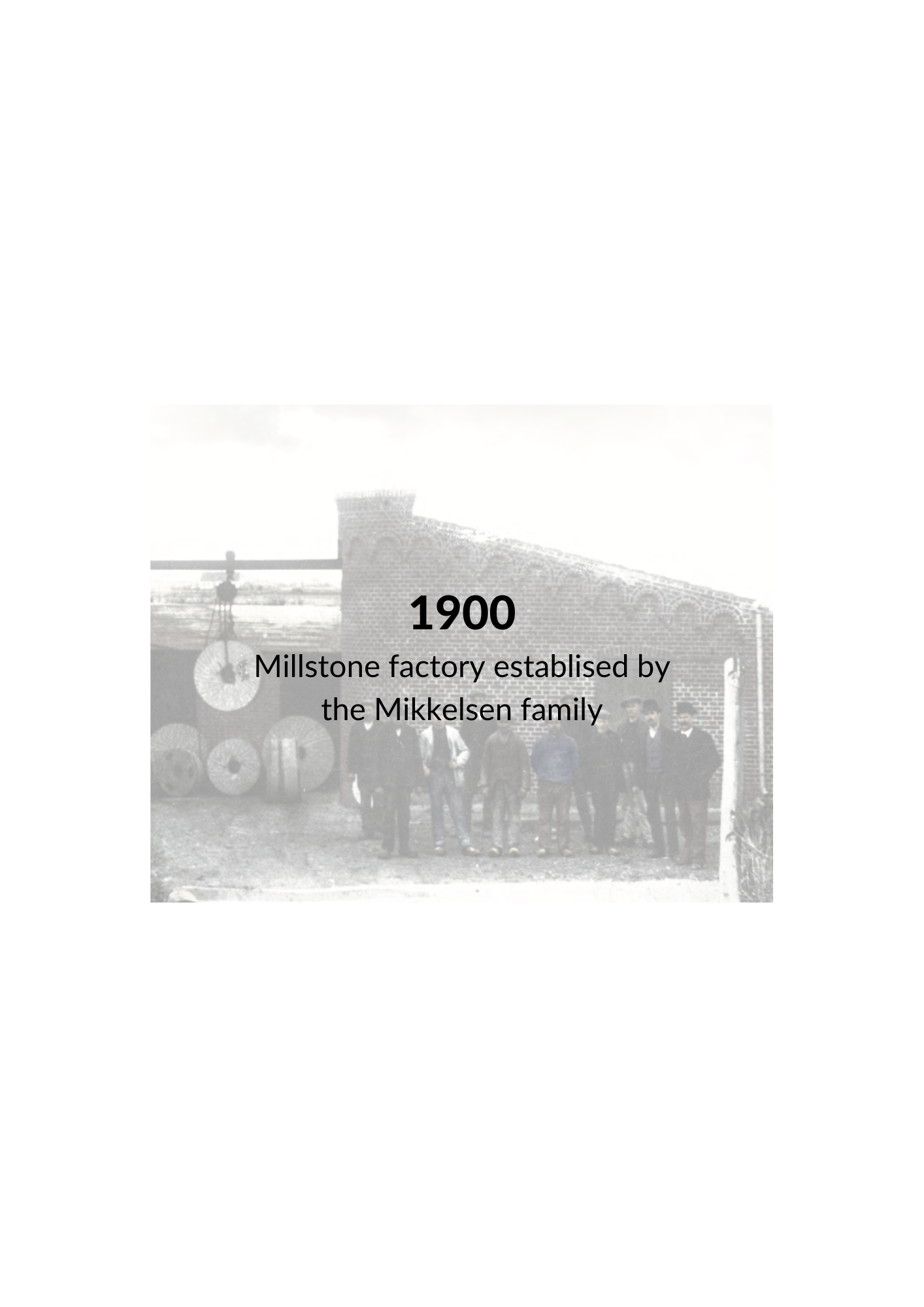about engsko
Engsko manufactures millstones, tailormade milling systems, and milling equipment, prioritizing quality and customer service. We have been in the milling business for over a century.
engsko's mission and vision
We aim to grow Engsko A/S into a global player in the stone milling segment by using timeless technology and innovative solutions.
We strive to bring innovative, sustainable, and organic solutions and products to our customers.
timeless technology
Timelessness means remaining unchanged, as good now as when first created. Since the third century, milling grain with two millstones—a stationary base stone and a runner stone—has remained the same and will continue unchanged.
sgd project with danchurchaid
DanChurchAid has obtained a grant from P4G, an initiative that connects public and private sectors in Food & Agriculture, to produce a nutritious biscuit for children suffering from malnutrition in Ethiopia.
The goal is to produce the biscuit with a local manufacturer in Ethiopia using technology from Danish companies. The biscuit will target children, as well as refugees and IDPs in Ethiopia, with the hope of scaling it to Kenya and Uganda.
the case about whole grains
The American Association of Cereal Chemists (2019) define whole grains as grains that consist of the intact, ground, cracked or flaked cereal seed whose principle anatomical components- the starchy endosperm, germ, and bran- are present in the same relative proportions as they exist in the intact seed. Whole grains include grains like wheat, maize (corn), rice, oats, barley, rye, sorghum, spelt when they are eaten in their whole form. Wheat, rice, and maize are the most widely consumed crops; these provide 60% of the world’s food energy intake (FAO, 2019). Since grains and their products like breakfast cereal are eaten routinely in many households, they are a dominant part of the standard diet and supply a significant proportion of energy and nutrient needs. Wheat flour is used to make bread, cookies, pasta, cakes, biscuits and is widely eaten all over the world as a common food. The whole kernel and most of the nutrients are retained in whole grain food giving it an extraction rate of 100%. Most of these nutrients are found in the bran and germ of the grain that are discarded when processing refined grains that are composed mainly of the endosperm, table 1 shows the micronutrients in the bran/germ fraction and endosperm. Grains have a similar structure where the kernel consists of three major parts: the endosperm, germ, and bran. The following illustration shows the structure of a wheat grain.
The bran which makes up about 14% of the whole grain is the hard-outer layer of the whole wheat grain. This layer contains dietary fiber, Vitamins B1, B2, B3, B6, minerals like iron, copper, zinc, magnesium, and selenium, and phytochemicals. The fiber in bran in essential in regulating and improving intestinal motility to maintain a healthy gastrointestinal tract. Fiber also promotes weight loss by reducing the feeling of hunger and therefore helps in weight loss. Phytonutrients also known as phytochemicals are plant chemicals present in whole grains, many of which have antioxidant activity that is associated with reduced risk for heart disease and stroke. Phytochemicals in whole grain are becoming recognized as playing an important role in reducing the risk of developing diseases like diabetes, heart disease, and cancer (Okarter and Liu, 2010).
The germ is the embryo of the seed from which the new plant sprouts. The germ makes up about 2.5% of the whole grain and contains all the minerals that are necessary for a new plant to grow. It contains B-vitamins, phytochemicals, and oil with antioxidants such as vitamin E. When exposed to oxygen, the oil in the germ causes whole grain flour to become rancid and thus gives whole grain flour a shorter shelf life when compared to refined flour. Removal of the germ gives a longer shelf life to refined flour while reducing its nutritional value. A longer shelf life is essential when the distribution process from milling to the consumer is long.
The endosperm is the largest part of the kernel accounting for approximately 83% of the weight of the grain. It is made up of carbohydrates, proteins, and small amounts of B-vitamins and minerals. It is the main source of white flour and 75% of it is starch. Roller milling enables the separation of the endosperm from the bran and germ to get flour that is mainly endosperm. Some of the nutrients that are lost during the milling process are added to the ground endosperm to make enriched flour.
In the late 1800s, roller mills were introduced to process flour at a faster rate than stone mills that had been used for centuries. Roller milling processed flour faster than the stone mills and created the energy dense and micronutrient poor refined flour by removing the bran and germ from the grain. Wherever roller milling took hold, epidemics of B-vitamins deficiencies like pellagra and beriberi followed. Removal of the germ and bran to produce refined grains by roller milling led to a range of vitamin B deficiency diseases (Winson, 2013). This new refined white flour with a lighter texture lasted longer on shelves without spoiling because of its inferior nutritional value. When the government realized the cause of the epidemics, laws were passed that required millers to add synthetic vitamins and micronutrients to the flour to restore some of the lost nutrients; this process creates enriched flour. 100% wholemeal flour does not need to be enriched. Most of the world’s flour is roller milled. While roller mills are large centrally placed facilities, stone mills are small-scale and require less investment than roller mills. Stone milling is still the milling of choice by artisan (skilled) bakers and natural food advocates. In roller milling, the different parts of the wheat kernel are separated and sometimes recombined after being milled separately. Stone milling is a straightforward process with single stream milling where all parts of the kernel are kept together from the beginning to the end of the milling process. Nutrients are higher in stone milled wheat flour compared to roller milled wheat flour due to low temperatures in stone milling that preserve the nutrients in the flour. A study showed that stone-milled flour had nearly 60% more vitamin E than roller milled wheat flour one day after milling (Engelsen and Hansen, 2008; Hansen, 2016). This shows that stone-milled flour retains most of the nutrients that are lost when flour is roller milled.
Whole-grain foods like wholemeal flour contains all the nutrients from the bran, germ, and endosperm in the same proportions as in the whole kernel. Refined flour has a reduced nutrition content as a large portion of the vitamins, minerals, and phytochemicals are lost with the removal of the germ and bran. To compensate for this loss, flour is enriched with nutrients. Enriched flour has comparable amounts of the vitamins and minerals found in wholemeal flour (see table 2) but has substantially lower levels of fiber with over 80% less fiber than wholemeal flour. Even with comparable amounts of vitamins, enriched flour has fewer nutritional benefits than whole-meal flour (Jonnalagadda, Harnack, Liu, Mckeown, Seal, Liu, and Fahey, 2011).
To address the diseases caused by the refined flour, some countries like the USA require that some of the nutrients lost in the milling process are replaced, a process called enrichment. While enrichment prevents the conditions caused by the vitamin deficiency, it does not replace all the nutrients that are lost. Figure 3 shows the percentage of nutrients in wholemeal, refined, and enriched wheat flour with wholemeal flour as the standard with 100% of the nutrients.
The extraction rate is the percentage of the whole grain that is turned into flour through the milling process. Wholemeal flour has a 100% extraction rate because it contains all parts of the grain. Refined flour which has the bran and germ removed has extraction rates that are as low as 72%. When 1kg of whole grains is processed to wholemeal flour, we get 1kg of wholemeal flour while we get as low as 0.7kgs of refined wheat flour wasting 30% of the grain. This leads to a waste of food that could ensure that more people are fed and has a negative effect on the planet.
The composition of flour can vary depending on the conditions where the wheat was grown and processed. While the World Health Organization and some governments require the enrichment of flour to replace the lost nutrients, not all millers can comply. A study in Kenya showed that nearly half of the millers in Kenya do not add essential nutrients to their flour even though enrichment is a legal requirement (JKUAT, 2019). Furthermore, enforcement of enrichment requirements is difficult in developing countries; this means that more people eat unenriched refined grains. Table 2 shows the compositions of wholemeal, unenriched and enriched white flour. Wholemeal flour has a superior nutrition profile.
Whole grains have multiple benefits to human health that are shown below. The World Health Organization and dietary guidelines for Americans recommend 3 or more servings of whole-grain products to be consumed per day to acquire these benefits. Eating at least 2 servings of whole grains reduces the risk of chronic diseases like type 2 diabetes, cardiovascular disease (heart disease), and obesity (Huang, Xu, Lee, Cho, and Qi, 2015).
Reduced risk of death from heart disease
Eating whole grain foods lowers bad cholesterol that is a major contributor to heart disease. According to a 2015 study, eating more whole grain resulted in lower death rates from heart disease among men and women (Wu et al, 2015). The chances of dying from heart disease were reduced in those who ate more whole grains even when other dietary and lifestyle factors were taken into consideration.
Reduced risk of type 2 diabetes
Multiple studies show that eating whole grains reduces the risk of type 2 diabetes and therefore support an increase in whole grain consumption (de Munter, Hu, Spiegelman, Franz and van Dam, 2007). Furthermore, they have showed that whole grain and bran intake reduces the risk of death from heart disease in women who have diabetes (He, van Dam, Rimm, Hu and Qi, 2010). Whole grains are high in fiber and are digested more slowly with a slow rise in blood sugar levels. Refined grains that are mainly made up of starch cause a faster rise in blood sugar levels as they are quickly converted to glucose. This spike in blood sugar increases the risk of developing type 2 diabetes.
Reduced risk of stroke
Eating whole grains reduced the risk for developing stroke in multiple studies (Liu et al, 2010). A higher intake of whole grain foods like wholemeal flour lowered the risk of ischemic stroke in women. Whole grains reduce the levels of bad cholesterol (Low density lipoprotein-LDL) which can build up in the arteries and lead to stroke.
Reduced risk of obesity
Whole grains contain fiber that has been shown to increase the feeling of fullness thus lowering appetite. Whole grain and wholemeal products are more filling than products from refined grains. Research has shown that individuals who have a higher intake of whole grains have a lower body mass index (BMI) and less belly fat (Roager et al, 2019; Harland and Garton, 2007). A higher BMI is seen in individuals who are overweight and obese; these conditions increase the risk for developing type 2 diabetes, heart disease, stroke, and cancer.
Healthy digestion
The insoluble fiber in whole grain enables the good bacteria in the intestines to flourish. Fiber is fermented in the large intestine and helps to maintain the large numbers of different bacteria that maintain health by reducing chronic inflammation (Roager, Vogt, Kristensen, et al, 2019). Fiber also increases the bulk of stool thus reducing constipation.
May reduce risk of cancer
Some research suggests that the consumption of whole grains might protect against gastrointestinal cancers.
Whole grains contain a wider range of vitamins, minerals, and phytonutrients than refined grains. Even with enrichment, refined and processed grains do not provide the same nutritional benefits as whole grains because some nutrients cannot be replaced. When you eat whole grains, you are not consuming a few added vitamins and minerals but a wide range of nutrients that work together for the best health outcome. No specific compounds or combination of compounds in the whole grain have been verified as reducing the risk of the diseases. The vitamins, minerals, fiber and phytochemicals in whole grains act together to reduce the risk of multiple diseases. The protection provided by eating whole grain foods is most likely from the interaction between the different compounds found in the grain thus removing these natural compounds and enriching the flour can fail to provide the same protection as when one eats whole grain. The interactions are not completely understood and thus the consumption of whole grain foods is recommended as the refined grains may fail to provide similar protection over the life course.
Childhood nutrition
Childhood is a critical period in the life course where the effects of malnutrition are tracked through adolescence, adulthood and to other generations. Child malnutrition is the biggest contributor to under 5 mortality due to increased susceptibility to infections and slow recovery from disease (UNICEF, 2019). Research shows that beyond the age of 2-3 years, the effects of chronic malnutrition are irreversible; these impact growth and brain development thus reducing educational attainment and economic productivity (UNICEF, 2019).
Processing the grains that make up the staple foods to which children are first introduced increases the risk of malnutrition over the life course. Dietary habits and tastes for food are developed during childhood. If a child grows up with a taste for refined food, these are the foods they are more likely to eat through adolescence and adulthood. A lifetime diet of high calorie-nutrient poor food will increase the global burden of chronic diseases that whole grains have been shown to prevent.
Global health
The changing global nutrition landscape with urbanization and acquisition of a western diet has contributed to the coexistence of undernutrition along with overweight and obesity within individuals, households and populations, across the life course; this phenomenon is known as the double burden of malnutrition (WHO, 2019). Malnutrition affects all regions of the world. There are millions who are suffering from physical hunger (macronutrient deficiency) and from hidden hunger (micronutrient deficiency) (WHO, 2019). There are rapid increases in rates of obesity and overweight in developing countries and the associated diseases like hypertension, stroke, and diabetes (Popkin, Adair, and Ng, 2012). While the refined grains can address physical hunger and some micronutrient needs, whole grains have a better nutritional profile that is better suited to addressing the double burden of malnutrition. Eating calorie-dense and low nutrient food will solve the problem of physical hunger but will not fully address the hidden hunger problem.
To end all forms of malnutrition, we need to change our focus from quantity to quality food. We need to reduce the supply of high calorie refined grains and increase the supply of quality highly nutritious whole grains like wholemeal flour. This is one of the factors that will play a role in making whole grains affordable and acceptable. As a dominant portion of a standard diet, whole grains have the potential to address the double burden of malnutrition. Consumption of whole grains can improve the intake of nutritious food thus ensuring a healthier diet. Feeding children with whole grains will enhance their ability to accept it and sustain proper nutrition to address the double burden of malnutrition over the life course.
- Obeying the law – We respect and obey the laws, rules, and regulations applying to our businesses around the world.
- Respecting human rights – We respect human rights and require our suppliers to do the same.
- Environment, health, and safety – We are committed to safeguarding the health and safety of our employees and protecting the environment.
- Respecting diversity – We are committed to respecting a culturally diverse workforce through practices that provide equal access and fair treatment to all employees.
- Integrity – We do not offer or accept bribes, kickbacks, or inappropriate gifts. We engage in business practices that are consistent with our ethics and values.
- Competing ethically – We do not engage in unethical or illegal trade practices.
faq
Here are some of the most common questions about Stone Milling
Can I buy spare parts for my stone grinding mill?
Yes, we have spare parts avaolable for our whole range of grinding mills, sifters and accessories
Do I need to learn any special skill to learn the craft of stone milling?
Stone Milling is a special craft so knowing how to mill with stone mills is a must. We offer training on site to all our customers
What does a stone grinding mill do?
A Stone Grinding Mill can grind different types of grains, spices, and coffee.
The product is ground between two millstones: a stationary stone and a runner stone.
Is stone milling products healthy?
Yes, not only is it healthy because it contains a natural balance of starch, protein, vitamins, and fibres, but it also preserves the essential vitamins B and E. When it comes to whole grains, only stone-milling can maintain the authentic flavor and nutritional goodness. Industrial processing removes the fiber and nutrients from the flour, leaving only the starchy endosperm.
Which product can I grind?
You can grind all types of grains, different types of spices and coffee on ENGSKO grinding mills
Do you ship internationally?
Yes, to all countries by air, sea and land
Can you help with installation?
Yes, we have a full installation team that we will send out; both for installation, training and commissioning
How long time does the mill stone last?
The mill stone will last several years, depending on what you grind and how many hours per day you operate.
As an overall, our mill stone will last up to 3 years before you need to change it.
This is based on running the stones 8 hrs per day for 6 days per week.
How many times can the millstones be re-dressed?
The millstone can be re-dressed up to 3-4 times
How much space is required for a Grinding Mill Plant?
- Our Baker´s Choice Milling Plant requires 30-50 sqm for operation.
- Our Miller´s Choice 250 will require 75-100 sqm.
- Our Miller´s Choice 500 will require 100-150 sqm.
- Our Miller´s Miller´s Choice 1000 will require 150-200 sqm.

